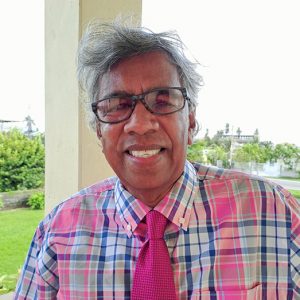I WOULD like to thank former President, Donald Ramotar for securing an early copy of Mrs. Jagan’s biography for me (I did pay for it). As you would know from reading all the book reviews I have done since 2024 started, I have completed them on the seawall while my dog roamed the crevices of the ambience looking for mongooses.
Written by Professor Emeritus Patricia Mohammed, Dr. Mohammed wrote about her subject, maybe unaware that over 75 per cent of the Guyanese population is under 45 and about 51 per cent is between the age of 16 and 18, and about 60 per cent is between the age of 18 and 35. This demographic content has to be taken into consideration when the scholar writes about a Guyanese who was an international personality that belonged to history.
Mrs. Jagan remains one of the great freedom fighters, radical feminists and working-class philosophers that the world produced. She belonged to a small, unknown country, but, comparatively speaking, her praxis made her one of the great freedom fighters that the 20th Century produced. As someone deeply familiar with 20th Century colonial politics and post-World War 2 politics, I would like to see at what number the historian would place Mrs. Jagan among top women leaders in the world. She has to be very high up the list.
I mentioned demography because Dr. Mohammed’s unawareness of this factor may result in countless number of young people not getting the holistic portrait of Mrs. Jagan. The priceless contribution of Mrs. Jagan to Guyana’s liberation, and Mrs. Jagan’s contribution to the rise of class consciousness in Guyana are not brought out adequately in this book.
Mrs. Jagan was a larger-than-life figure, and such status has to be analytically laid out for the young generation in Guyana. If it is not done, then this young generation may not know about the gigantic, phenomenal praxis of Mrs. Jagan.
What I hope to do in this short analysis here is to bring out the missing parts of Mrs. Jagan’s praxis that Dr. Mohamed did not capture, and I hope in doing so I can point the younger generation to the specific dimensions of Mrs. Jagan’s contributions that were phenomenal.
A biography must never rely on description only. The author has to put interpretation and analysis to what is described. In this respect, the recent biography of Forbes Burnham by Professor Linden Lewis is superb in the area of analysis. Professor Lewis was careful to analyze the moods, movement and melodies of Burnham.
Since space is tight, here are the areas of Mrs. Jagan’s praxis for which Guyana is indebted to her, and from which the current young crop of politicians should learn.
First, Mrs. Jagan put working class activism on the map of Guyana as an individual. While her party, the PPP, was infused with working class perspectives, Mrs. Jagan lived a working-class life, and shunned the ostentatiousness, gloss and pretence of urban middle-class life in Guyana.
One factor that may have been responsible for this is Mrs. Jagan’s extensive knowledge of the machinations of the Mulatto/Creole class against the PPP from the forties onwards. She did not trust that class, because she believed it was ultimately a class in itself for itself that hardly had any appreciation for the anti-colonial aspirations of the Guyanese proletariat, and the poor peasantry.
Baytoram Ramharack criticised Mrs. Jagan in his review of Dr. Mohammed’s book, pointing to Mrs. Jagan’s lack of contribution to the expansion of Indian culture. Ramharack asserted that Mrs. Jagan was more involved in Western culture in Guyana.
I think in his emphasis on race, Ramharack missed what Mrs. Jagan set out to do. She wanted to provide a platform for working-class artists, and she astutely achieved that by the birth of Castellani House (the National Art Gallery). Catellani House was the bedrock on which working-class artists were able to showcase their work.
Secondly, Mrs. Jagan was the custodian of the PPP’s astuteness in politics. I worked with Mrs. Jagan at the Michael Forde Bookstore in 1968 where I saw this. She had a deeper sense of the deceptive, secretive, labyrinthine and artificial nature of Guyanese politics. Because of their West Indianess, PPP leaders were more trustworthy of people who were in political rivalry to the PPP, and these people ended up deceiving the PPP umpteen times.
But Mrs. Jagan had this sixth sense about her. This explains why when Burnham invited the PPP to unity talks in 1984, Mrs. Jagan did not participate. For months the talks went on without Mrs. Jagan. She knew Burnham’s character better than her colleagues in the PPP. She was not without her faults (who is faultless), but, overall, Mrs. Jagan was and will remain one of the giants the world produced.
DISCLAIMER: The views and opinions expressed in this column are solely those of the author and do not necessarily reflect the official policy or position of the Guyana National Newspapers Limited.




.jpg)









